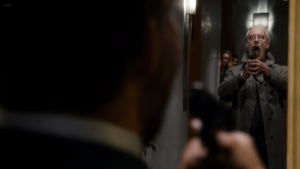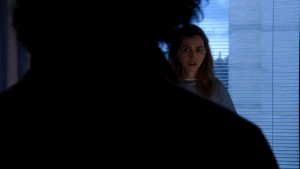Mitchell, Danielle. “Producing Containment: The Rhetorical Construction of Difference in Will & Grace.” Journal of Popular Culture, vol. 38, no. 6, 2005, pp. 1050-1068. ProQuest, http://prx.library.gatech.edu/login?url=https://search.proquest.com/docview/195371059?accountid=11107.
In this article, Mitchell rails against the prime time show Will & Grace for its acceptance of current norms of inequality and oppression. Her argument is similar to that of Myers regarding non-hegemonic male characters (see second source); that rather than acting as a role model for progress away from hegemonic and heterosexist ideals and norms, the depiction of homosexual characters in Will & Grace serves to reinforce these values by ridiculing characters who deviate from norms. In addition, Mitchell argues that Will & Grace has characters ridicule themselves in order to make the ridicule palatable to audiences who would normally find it offensive, and that it fails to truly represent racial minorities and lesbians by only having characters who represent those demographics make brief, token appearances.
This article definitely has a stance, and sticks to it. Mitchell intends the article to point out problems with Will & Grace’s representation of its characters, and focuses her analysis of the show in ways that support her argument. However, the article is still valuable due to its discussion of class and race divides within the LGBT community and its analysis of how those divides are being portrayed on prime time television.
Myers, Kristen. “”Cowboy Up!”: Non-Hegemonic Representations of Masculinity in Children’s Television Programming.” Journal of Men’s Studies, vol. 20, no. 2, 2012, pp. 125-143. ProQuest, http://prx.library.gatech.edu/login?url=https://search.proquest.com/docview/1023443734?accountid=11107.
In this article, Myers argues that “non-hegemonic male characters” in children’s television programs serve to reinforce hegemonic masculinity. She defines these characters as being males who are “not domineering, competitive, or sexually predatory” and clarifies that they comprise the majority of male characters in the studied shows. These shows are Suite Life on Deck, Hannah Montanna, Wizards of Waverly Place, and iCarly; from the Disney and Nickelodeon networks. The core of Myers’s argument is that rather than serving as role models of nontraditional gender hierarchy, these characters are subject to constant ridicule due to their failure to domineer other characters or otherwise assert their masculinity. Thus they ultimately reinforce that a successful male must put others down to maintain a role of power.
This source provides not only examples of children’s television perpetuating unhealthy gender roles, but also provides insight into how hegemonic masculinity is maintained within peer groups. The “Masculinities: Theory and Practice” section of this article notes that by age 10-11 boys have already identified that there is a relevant hierarchy of status among males in which one must prove oneself suitably masculine to advance. This hierarchy — and enforcement of it — lead to homophobic behaviors and oppression of individuals who do not conform to the cultural ideal of masculinity.
Newsom, Victoria A. “YOUNG FEMALES AS SUPER HEROES: SUPER HEROINES IN THE ANIMATED SAILOR MOON.” Femspec, vol. 5, no. 1, 2004, pp. 57. ProQuest, http://prx.library.gatech.edu/login?url=https://search.proquest.com/docview/200081515?accountid=11107.
In this article, Newsom dissects the concept of “girl power” and the gendered messages in Sailor Moon. She argues that Sailor Moon incorporates feminine characteristics into characters whose roles are historically associated with males, and therefore that it is part of third wave feminism. The main characters are girls who are strongly marked as feminine through emotional expression, behavior towards stereotypical subjects of teenage female attention such as make-up and crushes, and sexualized outfits. Meanwhile they fill the role of heroism historically reserved for male heroes: they defeat foes of monstrous proportions with supernatural abilities.
Newsome argues that the entire concept of “girl power” is based on a contradiction. It is intended as a “pleasure-centered form of empowerment,” and yet the manners in which it is depicted act counter to female empowerment, because characters who embody girl power are limited to young, slender, physically powerful, attractive girls. Newsome claims links between this unhealthily limiting image and the rise of eating disorders and other attempts at body alteration among female youth in the US.
This article provides information relevant to any research question about anime and shows aimed at young girls. It also highlights key differences between Japanese and American versions of the show and ways in which the American version was censored. It discusses sexualization of female characters in television and the male gaze. Additionally, it explores how an attempt at empowerment can exclude many people who do not fit a specific image.
Romo, Vanessa. “’Supergirl’ Casts First Transgender Superhero On Television.” NPR, NPR, 24 July 2018, www.npr.org/2018/07/23/631693257/supergirl-casts-first-transgender-superhero-on-television.
In this radio episode on NPR, Romo discusses the casting of Nicole Maines as the first transgender superhero on television in the show ‘Supergirl.’ Maines successfully sued her school district in Maine for the right to use the girls’ restroom after the school system had a “bodyguard” follow her around to ensure she used the staff restroom. The article also mentions Scarlett Johansson dropping a starring role as a trans character after public backlash and a general trend towards casting transgender actors for trans roles. In the words of Nicole Maines, this helps “show that we [transgender people] are valid in our identities and we exist.”
This article covers a new development in gender representation on television which is too recent to be covered in peer-reviewed articles. This article also provides a complement for the article by Newsom which discusses girl superheroes in an animated show, while this article centers around a live-action show.
Ulaby, Neda. “Working Women On Television: A Mixed Bag At Best.” NPR, NPR, 18 May 2013, www.npr.org/2013/05/18/184832930/working-women-on-television-a-mixed-bag-at-best.
In this radio episode from Weekend Edition Saturday on NPR, Ulaby discusses the various degrees to which women in the workforce are depicted on television. She reveals that children’s television portrays women as employed at a far lower rate than prime time television. In children’s programming “81 percent of jobs are held by men,” whereas almost half of female characters in prime time television are employed, which matches up with real-world percentages. However, very few of these characters have children, which contrasts with the 60% of real-life working women who have children.
This episode provides many useful metrics about portrayal of women in careers by television, which will be helpful in finding what questions have already been answered in order to ask a new question for our research. Additionally, it features interview snippets with an actress, a showrunner and a network president which provide insight into how the gender of a show’s main character affects its success.
Weida, Courtney L. “Gender, Aesthetics, and Sexuality in Play: Uneasy Lessons from Girls’ Dolls, Action Figures, and Television Programs.” The Journal of Social Theory in Art Education (Online), vol. 31, 2011, pp. 1-25. ProQuest, http://prx.library.gatech.edu/login?url=https://search.proquest.com/docview/1323178403?accountid=11107.
In this article, Weida analyzes many different ways in which Girls’ Dolls are played with and the learning implications of each of these methods of play. Additionally, she analyzes gendered messages in television shows Buffy The Vampire Slayer, South Park, and She-Ra. Rather than taking a direct stance on debates surrounding the media she is analyzing, Weida explores the various ways in which children subvert the expectations of advertisers and parents in playing with or viewing dolls and television, and the potential effects of these alternatives on the development and learning of the child.
Much of this article focuses on dolls, which are not inherently within the scope of our research. However, there is a recent television show about the barbie dolls. If this show is within the scope we choose for our question then the discussion of barbie dolls in this article will provide useful background information. The discussion of the aforementioned television shows and how they portray characters such as Willow from BTVS and Jimmy from South Park who are inherently unique and different from what is culturally considered normal has potential to be useful even if the Barbie shows are not within our chosen scope.









